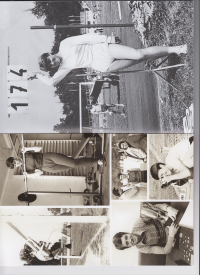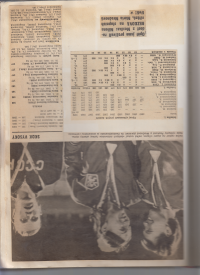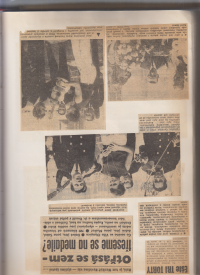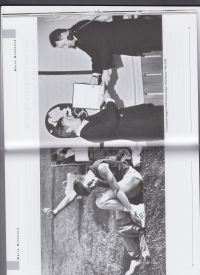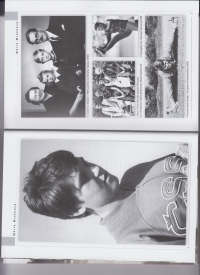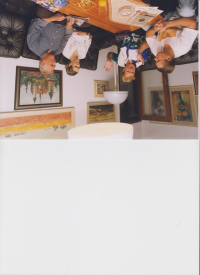Mária Mračnová, rod. Faithová
* 1946
-
In fact, I would be interested in further, but within socialism, the countries of the Eastern bloc lagged behind in many aspects. These were, as they were mostly technology, economy and so on, but I would be interested in whether in sports education or. Definitely like now, backwards, how would you look at it, those techniques and such on. Whether they may have reflected those world trends, if you look back, at that time, in the sixties.
Definitely not. Consider that the Mexican Olympics, the Olympic Games, started for the first time on tartan. We only had slag or clay courts, so it was a huge rebirth for us, because it's a completely different technique for slag and a completely different technique for tartan. Fortunately, before we went to Mexico, before the Olympics itself, because it was at a high altitude, they took us there three weeks in advance and we could prepare a bit for the tartan. But at home, sometimes up to four years later, a tartan stadium was built in Interi. Of course, apart from the fact that now I'm smiling when I look at those barbells, those gyms that are equipped with all sorts of tabored tinned strength machines and dumbbells, the maximum one-handed that you take in your hand. We only had the iron bar and the discs stacked on it, and with that we jumped or sat down and jumped up and did various exercises that were needed. Because I was one of those, I was a little high, so I made up for that strength with a rebounding force, and of course that strength could be gained by strengthening. I was one of the first to work systematically in the drill-hall, and that actually took me to those record heights. So the comparison of equipment at home and abroad has, that was, it was really unbeatable. I know that once we were preparing in the winter at the current bowling alley behind the basketball hall, it was like that, I don't know what kind of slag room it was and a landing area was built there, but we were heating with tiles, because it was a hell of cold, in winter and in three , we tried to train four tracksuit bottoms, and when we came to some of those modern halls outside or sometimes in Prague, we just opened our eyes in amazement.
It was probably a different world.
Totally different.
-
I was one hundred and ninety in Montreal, I jumped one hundred and ninety-nine. In Athens at the European Championships where I was third with the same performance as the winner. A year after the Olympics in '62, I jumped one hundred and eighty-three, I had jumped one hundred and eighty-three. It was just beautiful there that Milena won, so we were two on the podium and our anthem was playing. And so I felt that they played for me too.
And was the Olympics actually in the sixties?
Yes, it's been fifty-one years, fifty-two. We already had a meeting and there was a Czech goldsmith who, all volleyball players, athletes, we bought it, chains with an Aztec calendar. And it was a meeting fifty years from Mexico and we all showed it if we still have it, so there are different memories.
I would, in fact, ask Mexico about it, because getting to the Olympics must be like the total top.
And to Mexico.
And maybe from such a non-sports side that it was like feeling to meet the world with the other athletes, or how it went, if you could bring us closer to the Olympics.
It was definitely something special, extra. For the first time, we experienced such a long flight. Secondly, we lived in a women's village, they were twelve-story towers, men were separate, soldiers guarded us around. We could reach men, but they could not reach us. The next day, when we arrived, I actually had a birthday and suddenly he was hanging out, the Czechoslovak ambassador rolled over to us, I got Mexican music and cake, and we all ran down there and it was so much fun. So it was such a first smiling step to the Olympics. And the welcome at the stadium itself was beautiful. Firstly, for the first time in history, a woman lit a fire, the Olympic flame at the stadium, and then when we showed up at the stadium and everything was shouting "čeko, čeko".
And that was, in which month?
In October.
So that was in October.
In fact, I have such a piece of paper stored to this day, as the situation at the Ruzin airport has normalized, we can fly to the Olympics.
Otherwise, we'll get to the sixty-eight right away, but you still mentioned it.
Yes.
That you went for three weeks.
Yes.
That is how you spent that time, whether it was purely within those training or you had the opportunity to experience Mexico as well, as the culture and the world, or.
Well, yes. Once they took us to the pyramids, so I have photos like we scratched on top of the lunar solar pyramid. It was a really beautiful experience.
-
As part of this study otherwise, there was probably a focus on all the sports that it was still developing there.
Yes, yes, I still had to know how to swim, skate. I know that we had hockey at the winter stadium and Jano Starší stood opposite me and I stood in the goal without protectors without everything. He fired the puck so lightly, for two weeks I had a bruise on my whistle and such a lump that I had a hard time walking. We were also in training. We had to control boats, canoes, kayaks, hiking, bikes. Every year we had ski courses, so it was really challenging, and combined it also with that hard studium. Considering that we studied in Bratislava, I used to live in the Mountain Park for the first year, now go to winter, to Grossling, to PKO for gymnastics, to volleyball, to handball. And from biology again, there was, there was, there was a lot of subjects from biology at Moskovská, but botany was again opposite Lafranconi, and this circling all over the city, all day and so far only one-phase training was really quite, quite difficult to manage. So in the evening mostly, no trips, no discos, but just sleeping.
And were they actually dormitories or did you live in a private home?
In the dormitory. My mom retired when I went to college. She received a six hundred crowns pension and it was hard for them to support me in any way, so I then very much welcomed the fact that I received the so-called "kalorne" from ČSTV after the first record and after the first national team, which was six hundred crowns. You know, that was as much as my mom had a pension, so.
-
Full recordings
-
Ateliér Holubník - Bratislava, 30.10.2020
(audio)
duration: 01:59:10
Full recordings are available only for logged users.
“And this circling all over the city, all day and so far only one-phase training was really quite, quite difficult to manage. So most of the evenings, no trips, no discos, but just sleeping. ”
The memorial, Mária Mračnová, born Faithová, was born in Košice on September 24, 1946. She was born as the third child, at a relatively later age of her mother, at the age of thirty-nine. Mária’s mother Jolana Leščinská came from Svinice and her father Vojtech Leščinský from Spišské Vlachy. She has an older sibling, Norbert, who was born in 1939. Some time after him, her brother Ivan was born, who was born in the eighth month of pregnancy and died immediately after giving birth. Despite coming from a clerical family, she tended to play sports from an early age.
Mária attended the First Eight-Year Primary School in Košice and lived with her family on Komenského Street, near the VSS Stadium. After graduating from primary school in 1961, Mária continued at the Secondary General Education School in Košice until 1964. In both schools she was very lucky to support physical education teachers and even the teacher Stopka devoted her to her successful preparation for talent college exams. So, Mária studied at the Faculty of Physical Education and Sports, a combination of physical education and biology, teaching direction. Admission was subject to strict selection. She graduated in June 1970, when she was already pregnant. Although she was supposed to end in 1969, as much was missing due to representation and an individual plan was not possible, she ended a year later.
From the domestic competition, the memorial passed to the international one, already during her work in Košice, at the competition in Užhorod. Later in 1965, it was a more prestigious country, the Netherlands. The year 1966 was very successful and she completed almost 30 competitions, which were suffered her tendons. The big turning point was the Championship of the Czechoslovak Socialist Republic in Jablonec, where five adepts met for three places for the Olympic Games in Mexico (October 1968). With a performance of 178 cm, Mária was one of them. In 1969, she continued with the European Championships in Athens, and in 1976 with the Olympics in Montreal, where she won a personal record, 190 cm. Mária’s active career ended in an accident in 1980, near Liptovská Mara. For almost 14 years, Mária had no competition in her high-altitude category. The first better competitors came only in 1972.
Mária also met love at first sight and in 1967 she met her future husband at the Young Guard. He was a dental surgeon and devoted himself mainly to sports-men. Their son was born in 1970 and the memorial did not return to the national team until a year later. With a ten-year difference, they gave birth to a sibling, a daughter, in 1980.
After finishing her successful career, she did not want to devote herself to training. She has been involved in several positions. From 1992 to 2008 she worked as vice-chairwoman of the Olympic Committee and until 2014 as head of athletics in Slovakia. In addition to her family, both functions were very busy. She is currently devoted exclusively to her family.

